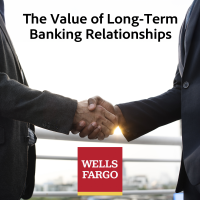The Value of Long-Term Banking Relationships
The Value of Long-Term Banking Relationships
Aaron Lemke, Wells Fargo Commercial Banking Leader
In January, the Ohio State’s National Center for the Middle Market released its Year-End report, showing there were approximately 200,000 middle market companies nationwide in 2024. Of these, the average age is 30 years and the median is 23.
One key insight from those metrics: although the impact of day-to-day events is considerable on middle market firms, their strategic planning horizon is much longer than the peak or valley of any given day, week, month, or quarter.
In my experience as a 20-year banking leader, and having served middle market businesses (ranging from $25 million to $2 billion in annual revenue) for the last 11 years, establishing a long-term relationship with a company is the ideal way to align financial advice and services with their nature.
However, to access this extended relationship value with a financial institution takes work from business leaders, in particular targeted research and communication to define their companies’ vision.
Step One: Research banks that prioritize culture and long-term client relationships
From my insider’s view, the ideal banking-client relationship is built on trust and understanding of the company’s growth and financial goals. Getting there takes time – literally years. And that’s much harder to accomplish at financial institutions that experience high turnover.
On top of that, changing banking relationships can be time consuming and unsettling. A banking relationship requires a long runway to educate the relationship team on company goals, priorities, challenges, and history. While it’s smart to periodically review direction and level of service with a financial partner, doing so too often can distract from maintaining focus on goals.
To avoid the disruptive costs of changing banking partners, and to reap the value that a longtime relationship brings, it benefits a company to find a bank that can accommodate its growth and financial goals with an array of services and products, while maintaining a culture that attracts and retains top banking talent.
The ideal relationship should give a company access not only to a strong collaborative partner, but to the bank’s leadership and customized product and service partners who are familiar with a business’s goals.
Step Two: Communicate to move from service provider to relationship advisor
March 2025 marks five years since the World Health Organization declared the COVID-19 pandemic.* With its onset, businesses found themselves immersed in rapid-fire transition, moving from in person meetings with both internal and external partners to primarily, if not solely, virtual communication tools.
After the pandemic, these modes, methods and increased hours of service continued, but none was able to replace the value of in-person connection.
My view: Businesses should consider the value of routine in-person meetings and collaborations with their banking partner. While virtual engagement may be easier to coordinate, face-to-face communication affords deeper understanding and relationship-building.
Step Three: Evaluate services to align with company vision
Determining company needs and evaluating efficiency can be hard in the best of times. Trying to anticipate future demands is exponentially harder. One pitfall many companies run into is determining their banking relationship value and criteria based only on the present day.
To develop successful, long-term banking relationships, middle market companies need to apply a futuristic lens, communicating the growth they hope to achieve and characteristics of the financial services partner that will help them get there.
Companies should review not only products, services, and access to industry/sector subject matter experts, but the banking relationship managers themselves. They should ask: Does this banking partner have the expertise and are they willing to invest the time to understand our business, industry, and vision, and are they committed to helping our company achieve its goals?
Step Four: Where the rubber meets the road
For many of the middle market companies I have worked with, the deepest banking relationships are forged during hard times. Relationships are easy when profits are up and targets are reached; it’s when challenges arise, and creative solutions are needed, that value is tested. While every outcome is not a guaranteed triumph, by following these steps to choose and maintain valuable, long-term relationships with their banking partners, businesses can help strengthen their chances of success.
As a business, identifying that partner who will be there in good times and bad, who will communicate with a desire to understand the issues at hand, and who will invest their resources to help achieve company goals, can be the difference between surviving and thriving.
* https://www.dcd.gov/museum/timeline/covid19.html
Wells Fargo Commercial Bank
-
Aaron Lemke Wells Fargo Commercial Banking Leader
- August 25, 2025
- 602-885-6751

